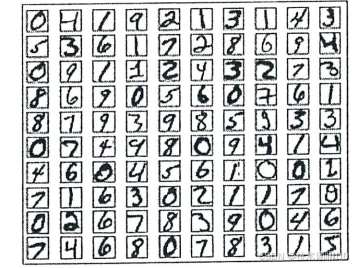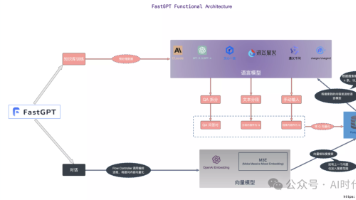Pytorch2学习(1)-利用U-Net大模型实现图像降噪
在此次我们的目的是对图片完成降噪处理,这里我们选的是UNet模型,它的核心任务是学习如何将一张输入图像(如手写数字)转换成一张有特定含义的输出图像。后续我会深入讲模型的选型问题。unet.py类# 模块化结构,这也是后面常用到的模型结构从图中我们可以看到,随着模型的训练,它逐渐学会了对输入数据进行整形和输出。
1. 数据准备
这里我为大家准备了手写数字图片的数据集MNIST,其中包含了60000个训练样本和10000个测试样本,如下图:
数据集下载链接:https://download.csdn.net/download/wu2374633583/92051855
2. 模型准备和介绍
在此次我们的目的是对图片完成降噪处理,这里我们选的是UNet模型,它的核心任务是学习如何将一张输入图像(如手写数字)转换成一张有特定含义的输出图像。
后续我会深入讲模型的选型问题。
2.1 模型下载
链接:https://download.csdn.net/download/wu2374633583/92051862
2.2 模型定义代码
unet.py类
import numpy as np
import torch
# x_train = np.load('./mnist/x_train.npy')
# y_train = np.load('./mnist/y_train_label.npy')
# print(x_train.shape)
class Unet(torch.nn.Module):
def __init__(self):
super(Unet, self).__init__()
# 模块化结构,这也是后面常用到的模型结构
self.first_block_down = torch.nn.Sequential(
torch.nn.Conv2d(in_channels=1, out_channels=32, kernel_size=3, padding=1), torch.nn.GELU(),
torch.nn.MaxPool2d(kernel_size=2, stride=2)
)
self.second_block_down = torch.nn.Sequential(
torch.nn.Conv2d(in_channels=32, out_channels=64, kernel_size=3, padding=1), torch.nn.GELU(),
torch.nn.MaxPool2d(kernel_size=2, stride=2)
)
self.latent_space_block = torch.nn.Sequential(
torch.nn.Conv2d(in_channels=64, out_channels=128, kernel_size=3, padding=1), torch.nn.GELU(),
)
self.second_block_up = torch.nn.Sequential(
torch.nn.Upsample(scale_factor=2),
torch.nn.Conv2d(in_channels=128, out_channels=64, kernel_size=3, padding=1), torch.nn.GELU(),
)
self.first_block_up = torch.nn.Sequential(
torch.nn.Upsample(scale_factor=2),
torch.nn.Conv2d(in_channels=64, out_channels=32, kernel_size=3, padding=1), torch.nn.GELU(),
)
self.convUP_end = torch.nn.Sequential(
torch.nn.Conv2d(in_channels=32, out_channels=1, kernel_size=3, padding=1),
torch.nn.Tanh()
)
def forward(self,img_tensor):
image = img_tensor
image = self.first_block_down(image)#;print(image.shape) # torch.Size([5, 32, 14, 14])
image = self.second_block_down(image)#;print(image.shape) # torch.Size([5, 16, 7, 7])
image = self.latent_space_block(image)#;print(image.shape) # torch.Size([5, 8, 7, 7])
image = self.second_block_up(image)#;print(image.shape) # torch.Size([5, 16, 14, 14])
image = self.first_block_up(image)#;print(image.shape) # torch.Size([5, 32, 28, 28])
image = self.convUP_end(image)#;print(image.shape) # torch.Size([5, 32, 28, 28])
return image
if __name__ == '__main__':
image = torch.randn(size=(5,1,28,28))
unet_model = Unet()
torch.save(unet_model, './unet_model.pth')
2.3 模型架构解读
U-Net模型的核心是一个编码器-解码器结构,形状像字母“U”。
-
编码器(下采样路径):first_block_down和second_block_down模块负责此项工作。它们通过卷积层提取图像特征,再通过池化层压缩图像尺寸。这个过程可以理解为不断“抓住”图像中最重要的信息(比如物体的轮廓、纹理),但会忽略一些细节。
-
瓶颈层:latent_space_block是连接编码器和解码器的关键部分。它处理的是被高度压缩后的信息,这些信息包含了图像最核心、最抽象的语义特征。
-
解码器(上采样路径):second_block_up和first_block_up模块负责此项工作。它们通过上采样操作将特征图的尺寸逐步放大,恢复细节,最终目标是还原到输入图像的尺寸。
2.4 关键组件与数据流
在 forward函数中,你可以清晰地看到一张图像是如何流经这个模型的:
def forward(self, img_tensor):
image = img_tensor # 输入图像,尺寸为 [批次大小, 通道数, 高, 宽],例如 [5, 1, 28, 28]
image = self.first_block_down(image) # 下采样 -> [5, 32, 14, 14]
image = self.second_block_down(image) # 下采样 -> [5, 64, 7, 7]
image = self.latent_space_block(image) # 特征提取 -> [5, 128, 7, 7]
image = self.second_block_up(image) # 上采样 -> [5, 64, 14, 14]
image = self.first_block_up(image) # 上采样 -> [5, 32, 28, 28]
image = self.convUP_end(image) # 输出层 -> [5, 1, 28, 28]
return image
输出层使用的 Tanh()激活函数会将每个像素的值压缩到 -1 到 1 的范围内。这表明该模型可能用于图像生成或去噪等任务,需要输出像素值范围较广的图像,而不是像分割任务那样输出概率。
2.5 典型应用场景
基于其结构,这个模型可能用于以下任务:
-
图像分割:尤其是医学影像(细胞、器官)、卫星图像分析或道路裂纹检测。
-
图像生成与重建:由于输出使用了 Tanh,也可能用于简单的图像生成或去噪任务。
3. 对目标的逼近-模型的损失函数和优化函数
要完成一个深度学习项目,一个非常重要的内容就是设定模型的损失函数和优化函数。这里我们采用的是均方损失函数MSELoss。它的作用就是计算预测值和真实值之间的欧氏距离,二者越接近,均方差就越小。
4. 基于深度学习模型训练
4.1 完整代码
import os
os.environ['CUDA_VISIBLE_DEVICES'] = '0'
import torch
import numpy as np
import unet
import matplotlib.pyplot as plt
from tqdm import tqdm
# 创建保存图像的目录
img_dir = "./img"
if not os.path.exists(img_dir):
os.makedirs(img_dir)
print(f"创建目录: {img_dir}")
batch_size = 320 #设定每次训练的批次数
epochs = 1024 #设定训练次数
#device = "cpu" #Pytorch的特性,需要指定计算的硬件,如果没有GPU的存在,就使用CPU进行计算
device = "cuda" #在这里读者默认使用GPU,如果读者出现运行问题可以将其改成cpu模式
model = unet.Unet() #导入Unet模型
model = model.to(device) #将计算模型传入GPU硬件等待计算
#model = torch.compile(model) #Pytorch2.0的特性,加速计算速度 选择使用内容
optimizer = torch.optim.Adam(model.parameters(), lr=2e-5) #设定优化函数
#载入数据
x_train = np.load("./mnist/x_train.npy")
y_train_label = np.load("./mnist/y_train_label.npy")
x_train_batch = []
for i in range(len(y_train_label)):
if y_train_label[i] <= 10: #为了加速演示作者只对数据集中的小于2的数字,也就是0和1进行运行,读者可以自行增加训练个数
x_train_batch.append(x_train[i])
x_train = np.reshape(x_train_batch, [-1, 1, 28, 28]) #修正数据输入维度:([30596, 28, 28])
x_train /= 512.
train_length = len(x_train) * 20 #增加数据的单词循环次数
#state_dict = torch.load("./saver/unet.pth")
#model.load_state_dict(state_dict)
for epoch in range(30):
train_num = train_length // batch_size #计算有多少批次数
train_loss = 0 #用于损失函数的统计
for i in tqdm(range(train_num)): #开始循环训练
x_imgs_batch = [] #创建数据的临时存储位置
x_step_batch = []
y_batch = []
# 对每个批次内的数据进行处理
for b in range(batch_size):
img = x_train[np.random.randint(x_train.shape[0])] #提取单个图片内容
x = img
y = img
x_imgs_batch.append(x)
y_batch.append(y)
#将批次数据转化为Pytorch对应的tensor格式并将其传入GPU中
x_imgs_batch = torch.tensor(x_imgs_batch).float().to(device)
y_batch = torch.tensor(y_batch).float().to(device)
pred = model(x_imgs_batch) #对模型进行正向计算
loss = torch.nn.MSELoss(reduction="sum")(pred, y_batch)*100. #使用损失函数进行计算
#这里读者记住下面就是固定格式,一般而言这样使用即可
optimizer.zero_grad() #对结果进行优化计算
loss.backward() #损失值的反向传播
optimizer.step() #对参数进行更新
train_loss += loss.item() #记录每个批次的损失值
#计算并打印损失值
train_loss /= train_num
print("train_loss:", train_loss)
if epoch%6 == 0:
torch.save(model.state_dict(),"./unet_model.pth")
# 下面是对数据进行打印
image = x_train[np.random.randint(x_train.shape[0])]
image = np.reshape(image, [1, 1, 28, 28])
image = torch.tensor(image).float().to(device)
image = model(image)
image = torch.reshape(image, shape=[28, 28])
image = image.detach().cpu().numpy()
# 保存图像 - 现在目录已经存在
plt.imshow(image)
plt.savefig(f"./img/img_{epoch}.jpg")
4.2 代码解读
1、环境设置与导入模块
import os
os.environ['CUDA_VISIBLE_DEVICES'] = '0' # 设置使用哪个GPU
import torch
import numpy as np
import unet # 自定义的U-Net模型
import matplotlib.pyplot as plt
from tqdm import tqdm # 进度条工具
- 配置计算环境,优先使用GPU(CUDA)加速训练
- 导入必要的深度学习库:PyTorch用于张量计算,NumPy用于数值处理,matplotlib用于可视化
2、创建输出目录
img_dir = "./img"
if not os.path.exists(img_dir):
os.makedirs(img_dir)
print(f"创建目录: {img_dir}")
-
os.path.exists()和 os.makedirs()是文件系统操作,类似Java的File.exists()和File.mkdirs()
-
f"字符串{变量}"是f-string格式,Python 3.6+的特性。
3、超参数设置与设备选择
batch_size = 320 # 每次训练输入的样本数
epochs = 1024 # 训练轮数
device = "cuda" # 使用GPU加速
- Batch Size: 一次迭代中处理的样本数量,影响训练速度和内存使用。
- Epoch: 整个训练数据集被完整遍历一次的计数。
- GPU加速: 使用CUDA可以大幅提升矩阵运算速度,这对深度学习至关重要。
4、模型初始化
model = unet.Unet() # 实例化U-Net模型
model = model.to(device) # 将模型移至GPU
optimizer = torch.optim.Adam(model.parameters(), lr=2e-5) # 优化器
- Adam优化器自适应调整学习率,比传统梯度下降更高效。学习率lr=2e-5控制参数更新步长。
5、数据加载与预处理
x_train = np.load("./mnist/x_train.npy") # 加载训练数据
y_train_label = np.load("./mnist/y_train_label.npy") # 加载标签
# 过滤数据,只使用标签<=10的样本
x_train_batch = []
for i in range(len(y_train_label)):
if y_train_label[i] <= 10:
x_train_batch.append(x_train[i])
# 数据重塑和归一化
x_train = np.reshape(x_train_batch, [-1, 1, 28, 28]) # 调整维度
x_train /= 512. # 像素值归一化到[0,1]范围
train_length = len(x_train) * 20 # 增加数据循环次数
- 维度调整: reshape([-1, 1, 28, 28])将数据变为(batch_size, 通道数, 高度,宽度)格式,PyTorch需要此格式。
- 数据归一化: 将像素值从0-255缩放到0-1之间,提高训练稳定性和收敛速度。
- 数据过滤: 只使用部分类别(0-10)加速演示训练过程。
6、训练循环核心逻辑
for epoch in range(30): # 外层训练循环
train_num = train_length // batch_size # 计算批次数
train_loss = 0
for i in tqdm(range(train_num)): # 进度条显示
# 准备批次数据
x_imgs_batch = []
y_batch = []
for b in range(batch_size):
img = x_train[np.random.randint(x_train.shape[0])] # 随机采样
x_imgs_batch.append(img)
y_batch.append(img) # 本例中输入和目标相同(自编码器任务)
# 转换为PyTorch张量并移至GPU
x_imgs_batch = torch.tensor(x_imgs_batch).float().to(device)
y_batch = torch.tensor(y_batch).float().to(device)
# 前向传播
pred = model(x_imgs_batch)
loss = torch.nn.MSELoss(reduction="sum")(pred, y_batch) * 100.
# 反向传播与优化
optimizer.zero_grad() # 清零梯度
loss.backward() # 计算梯度
optimizer.step() # 更新参数
train_loss += loss.item() # 累积损失
训练过程详解:
- 前向传播:输入数据通过模型计算预测输出 损失计算:使用均方误差(MSE)
- 衡量预测与真实值的差异
- 反向传播:自动计算损失函数对模型参数的梯度
- 参数更新:优化器根据梯度更新模型权重
7、 模型保存与结果可视化
# 定期保存模型
if epoch % 6 == 0:
torch.save(model.state_dict(), "./unet_model.pth")
# 生成示例图像
image = x_train[np.random.randint(x_train.shape[0])]
image = np.reshape(image, [1, 1, 28, 28])
image = torch.tensor(image).float().to(device)
image = model(image) # 模型推理
# 结果可视化
image = torch.reshape(image, shape=[28, 28])
image = image.detach().cpu().numpy() # 移回CPU并转NumPy
plt.imshow(image)
plt.savefig(f"./img/img_{epoch}.jpg")
模型保存机制:
- model.state_dict()保存模型参数而非整个模型,便于跨平台部署
- PyTorch的.pth文件包含张量字典,类似Java的序列化对象
可视化重要性:
- 深度学习训练中,可视化帮助监控模型表现,检测训练问题。这里每6个epoch保存一次生成图像。
4.3 最后训练效果展示

从图中我们可以看到,随着模型的训练,它逐渐学会了对输入数据进行整形和输出。
更多推荐
 已为社区贡献1条内容
已为社区贡献1条内容







所有评论(0)